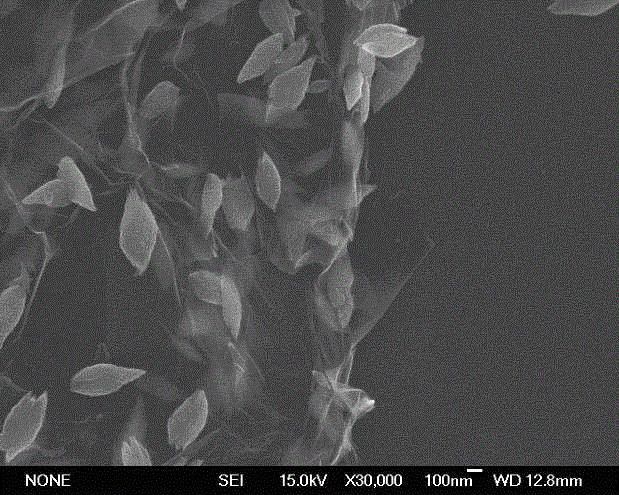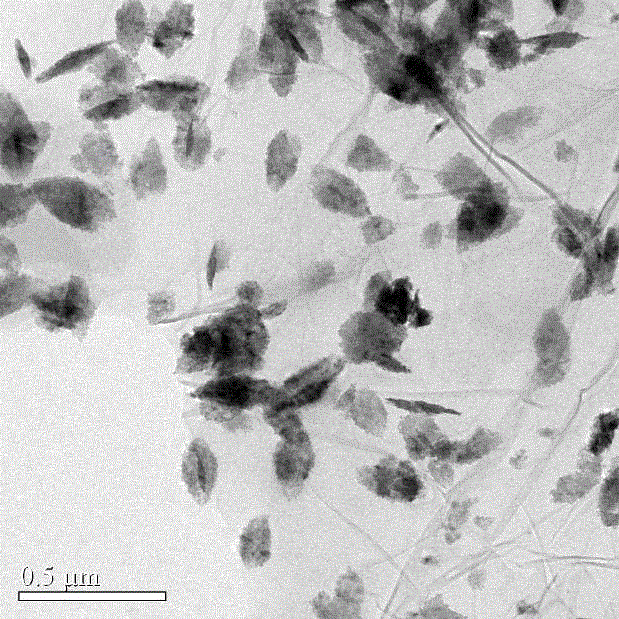Graphene-loaded lamellar cupric oxide composite material and hydro-thermal synthesis method thereof
A composite material and hydrothermal synthesis technology, which is applied in the field of electrochemistry and material synthesis, can solve the problems of easy agglomeration of copper oxide materials, long charging time, and low power density, and achieve short preparation cycle, improved capacitance performance, and large output. Effect
- Summary
- Abstract
- Description
- Claims
- Application Information
AI Technical Summary
Problems solved by technology
Method used
Image
Examples
Embodiment 1
[0031] Embodiment one : Preparation of graphene-supported sheet-like copper oxide composites with copper nitrate as copper source.
[0032] Potassium persulfate (K 2 S 2 o 8 ) 2.5 g, phosphorus pentoxide (P 2 o 5 ) 2.5 g, dissolved in 12 mL of concentrated sulfuric acid, heated to 80°C; then 3 g of natural graphite was added to the above solution, kept at 80°C for 4.5 hours; cooled to room temperature, diluted with 500 mL of deionized water, and left standing overnight ; filter, float residual acid with 0.2 mm filter; dry in a vacuum oven at 60°C; add the obtained preoxide to 120 mL of ice-bathed concentrated sulfuric acid, slowly add 15 g of KMnO under stirring 4 , Keep the temperature below 20°C during the addition process. Then the temperature was controlled at 35°C and stirred for 2 h. Add 250 mL of deionized water to dilute, and keep the temperature below 50°C in an ice bath during the dilution process. Stir for another 2 h, add 0.7 L of deionized water, and imme...
Embodiment 2
[0036] Embodiment two : Preparation of graphene-supported sheet-like copper oxide composites with copper acetate as copper source.
[0037] Take 0.8 g of copper acetate and add it to 75 mL of deionized water, add 90 mg of graphene into it, stir for 15 min, ultrasonicate for 0.5 h, add 15 ml of 0.3M ammonium carbonate dropwise, put it into the reaction kettle, and keep the temperature at 100°C6 h. Centrifuge, wash with alcohol, and wash with water three times each to obtain the product. The capacity of the prepared material measured by electrochemical test is 321.7 F / g.
Embodiment 3
[0038] Embodiment Three : Using ethylene glycol as a solution to prepare graphene-supported sheet-like copper oxide composites.
[0039] Take 0.6 g of copper nitrate and add it to 70 mL of ethylene glycol, add 90 mg of graphene to it, stir for 15 min, sonicate for 0.5 h, add 20 ml of 0.3M ammonium bicarbonate dropwise, put it into the reaction kettle, and keep the temperature at 120 ℃4h. Centrifuge, wash with alcohol, and wash with water three times each to obtain the product. The prepared material has an electrochemical test capacity of 303.0 F / g.
PUM
| Property | Measurement | Unit |
|---|---|---|
| width | aaaaa | aaaaa |
| length | aaaaa | aaaaa |
| size | aaaaa | aaaaa |
Abstract
Description
Claims
Application Information
 Login to View More
Login to View More - R&D
- Intellectual Property
- Life Sciences
- Materials
- Tech Scout
- Unparalleled Data Quality
- Higher Quality Content
- 60% Fewer Hallucinations
Browse by: Latest US Patents, China's latest patents, Technical Efficacy Thesaurus, Application Domain, Technology Topic, Popular Technical Reports.
© 2025 PatSnap. All rights reserved.Legal|Privacy policy|Modern Slavery Act Transparency Statement|Sitemap|About US| Contact US: help@patsnap.com



